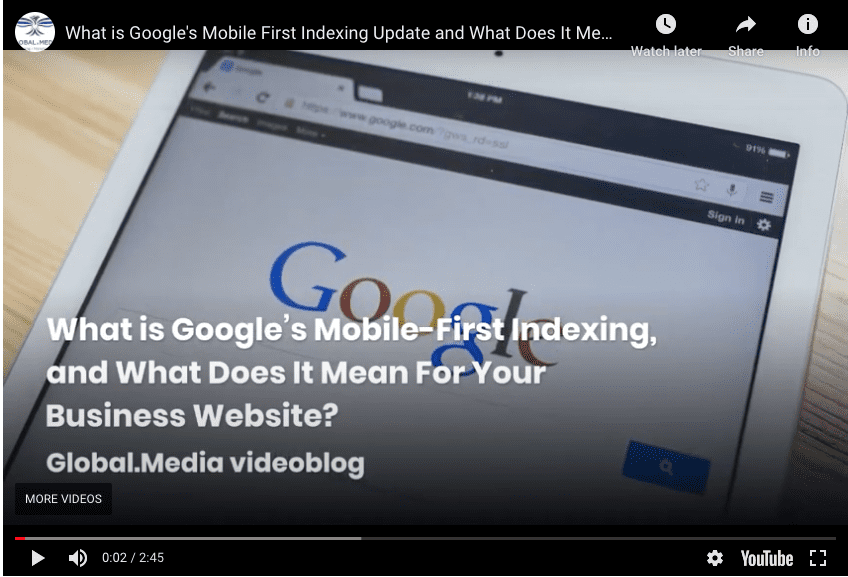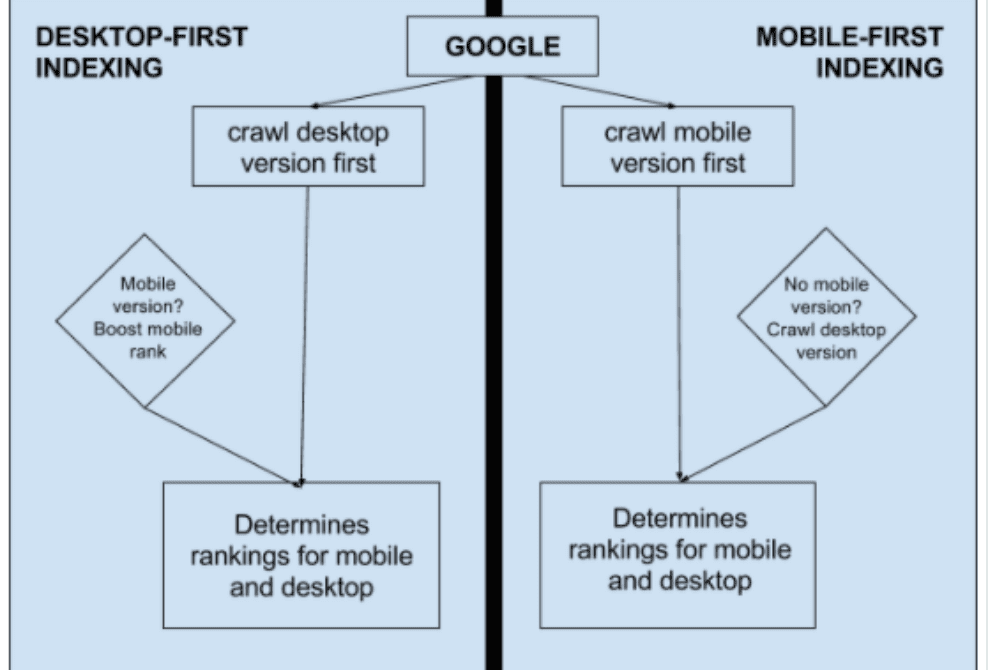What is Google’s Mobile-First Indexing, and What Does It Mean For Your Business Website? videoblog

by EnyOsung
One of the first blogs I wrote when I started my business in 2015 was about ‘mobilegeddon’ and the so-called mobile-apocalypse. (You can see it here: https://globaldotmedia.com/google-bing-mobile-friendly-ratings-explained)
These terms related to the likely reduced search rankings and visibility that businesses would expect to experience on search engine results pages if Google deemed them not to be mobile-friendly as a consequence of Google’s Mobile-Friendly rankings update. Since then, Google has continued to tweak it’s indexing system and ranking criteria while mobile devices have become the dominant device for consumers searching the Web. Google’s latest search rankings update – it’s mobile-first indexing became the default methods that it uses to index websites on 1st July 2019. A year on, I still see businesses that develop their website with a total focus on the desktop experience. I have never seen a client mention mobile-first indexing in the specifications for website development projects that we have received. In an age when there is a prevalence of DIY website makers like Wix and Squarespace, the pitfalls for website owners/developers are even more significant. It is as if they do not appreciate the importance of the mobile-first indexing update on their businesses’ visibility. Read on to learn about the journey of the rise of mobile rankings in search visibility over the years. We will also turn the spotlight on what the mobile-first indexing means and why it is critical to your e-commerce business.
Businesses have had to come to terms with the seismic shift that mobile devices have brought to the way consumers search the Web for online service providers. No UK e-commerce business can afford to not pay attention to Google’s rankings updates, given that it is the biggest search engine in the UK search market with more than 90% of the search market. However, by focusing on Google’s search rankings factors alone, you risk missing out on the remaining quarter of your potential customers who are searching on the other dominant search platforms: Microsoft’s Bing and the ever-depreciating Yahoo.
The good news is that where Google goes, Bing and Yahoo go too. So getting your mobile-first index correct will bring greater visibility on all of the major search engines.
These roll-outs do not happen overnight. It takes weeks and possibly years for Google’s rankings update to take full effect. There is no reason to believe that the mobile-first-indexing will not be the same. The important thing is to understand the change that is underway and begin to adapt your business and website to continue to maintain your search ranking or even improve it in the context of the latest update.
A quick history of mobile search
There was a time when desktop computers were king. In those halcyon days, people routinely logged into their desktop computers to browse the Web, send emails and more. The emergence of smartphones and tablets quickly changed the desktop’s dominance.
- Summer 2013 – Searches on mobile devices outstrip desktop searches.
- 2015 – 7.1 billion people on earth own 7.7 billion mobile handsets, with many people owning two or more devices with three-quarters of searches now on mobile (Marketo)
- April 2015 – Google publishes mobile-friendly update: websites deemed to be non-mobile-friendly decreased by 21 per cent on the first three pages (30 results) of Google. Interestingly, the most significant change was on page three, with a 25 per cent decrease.
- November 2016:Google started experimenting with making the index mobile-first.
- December 2017: Google is evaluating sites for readiness and cautiously rolling out mobile-first indexing for websites that are ready.
- March 2018:Mobile-first indexing is rolling out more broadly.
- 1st July 2019 – Google begins rolls out of mobile-first indexing as default on new websites not previously known to the search engine and begins migrating existing sites that meet the criteria to mobile-first indexing.
The stated rise in mobile search has been matched by Google’s focus on providing an indexing method to provide search results that delight mobile users.
Challenges of going mobile
The rise of mobile searches has presented issues for businesses to provide a seamless website user experience. We have long-known the difficulties that legacy websites and running mobile versions of the site bring.
Mir Rosenberg (Principal Program Manager at Bing) lists some of the challenges for mobile relevance when compared to “traditional” importance as follows:
- It is easy to type URLs on PCs and Macs, but it’s more cumbersome on phones.
- Some sites have mobile-incompatible content. For example, a non-mobile-friendly search result may send you to a page with fonts or buttons so small that you can barely use it without zooming or pinching — if at all.
- Some pages that work fine on a PC or Mac can be useless on some mobile devices, think Flash-only pages on iOS.
- In some cases, the “normal” URL redirects to a mobile version, which not only wastes user’s time but also consumes bandwidth on their data plans.
Developing multiple versions of a website based on different devices and tactile functions was a typical response to the need to provide a mobile-friendly experience. The biggest issue with the first multiple-site approach is that each version of a website exists independently from one another. It was, therefore, harder to keep up with technology as it progresses. Furthermore, it also can become very costly to hire a developer for every upgrade and change on each version. The old approach of coding one ‘desktop’ site and one ‘mobile’ site was becoming increasingly untenable.
Responsive web design (RWD), first mentioned in 2010 was, in essence, a method of design, which hoped to achieve an optimal user experience on any device. Although RWD was new and changed many aspects of the knowledge of the mobile user’s for the better, there are still some things it does not entirely address yet. Some of the problems include the importance of ad placement and elements on a page. It also does not allow sites to maintain their unique design.
The answers about how RWD would evolve that business was waiting for came in the form of an article by Ethan Marcotte. This humble web developer looked at architectural principles to explain how we could create device-agnostic layouts that adapt seamlessly to different screen environments, yet still retain the best principles of print design. His essay, entitled Responsive Web Design, introduced a new more straightforward, more elegant and practical approach that became as the standard way to design a site, and remains so today.
Mobile-first indexing – what is it?
Since the majority of users now access Google Search with a mobile device, Google wants to give users the best Web experience on their mobile devices. Mobile-first indexing is one of the strategies to encourage businesses to whole-heartedly commit to delivering the optimal experience of their website on mobile. It is worth understanding what mobile-first indexing is and what it is not.
It is easy to assume that the announcement of the roll-out means businesses must change everything about their website to continue to get high search rankings. A complete overhaul is not the case because, for many companies, especially those that already have responsive websites, there will be little change if any, to continue to be visible on search engine results pages. The businesses that do not have a responsive website may have to make changes to avoid a potential reduction in their rankings. Companies that want higher rankings can follow the best search engine optimisation practices to maximise their presence.
Moz breaks down mobile-first indexing with this simple graphic that I love:
Mobile-first indexing means that Google will be crawling and indexing websites based on the mobile version of your website. Previously, search engines indexed your website based on the desktop experience that typically gives visitors the full experience of your online home. The mobile version of your website is now the default view that Google catalogues. Google says that: We’re happy to see how the Web has evolved from being focused on the desktop to become mobile-friendly, and now to being mostly crawlable and indexable with mobile user-agents!
They further add that: While we continue to support responsive web design, dynamic serving, and separate mobile URLs for mobile websites, we recommend responsive web design for new sites. Because of issues and confusion we’ve seen from different mobile URLs over the years, both from search engines and users, we recommend using a single URL for both desktop and mobile websites.
1st July 2019 Roll-out tells us that all new websites will rank in search results based on the information that the smartphone Googlebot indexes from crawling the site. It is worth emphasising that mobile-friendliness and mobile-responsive layouts are not mandatory for mobile-first indexing. Since pages without mobile versions still work on a mobile device, they are therefore eligible for indexing.
What mobile-first indexing means for your business
For most existing website owners, if you are happy with your search rankings, then you do not have to do much to have your website migrated to Google’s mobile-first indexing. Google will do the crawl automatically when you have a level of similar experience on mobile as on desktop. In Google’s words, for existing websites, we determine their readiness for mobile-first indexing based on parity of content (including text, images, videos, links), structured data, and other meta-data (for example, titles and descriptions, robots meta tags). We recommend double-checking these factors when a website is launched or significantly redesigned. You can continue to check for mobile-first indexing of your website by using the URL Inspection Tool in Search Console.
Mobile-first indexing for New websites
New websites will be automatically crawled and indexed using the smartphone Googlebot; you cannot opt-out. Search Engine Land advises that If you launch a new website that doesn’t work well in mobile, then you may have issues with indexing and ranking in Google. So make sure to test your site and build them in a mobile-first manner.
Google states clearly that a new website must make sure that your mobile site contains the same content as your desktop site. They warn that if your mobile site has less content than your desktop site, consider updating your mobile site so that its original content is equivalent to your desktop site. If you are aiming for the mobile page should have less content than the desktop page, you can expect some traffic loss when your site is enabled mobile-first indexing since Google can’t get as much information from your page as before.
The critical task facing new websites according to have a chance of excellent visibility on mobile, according to Google is to ensure that smartphone Googlebot can crawl and render your website by addressing these key considerations:
- Use the same meta robots tags on the mobile and desktop site.If you use a different meta robots tag on the mobile website (especially noindex or nofollow), Google may fail to crawl and index your page when your site is enabled for mobile-first indexing.
- Don’t lazy-load original content upon user interaction. Googlebot won’t load content that requires user interactions (for example, swiping, clicking, or typing) to load. Make sure that Google can see lazy-loaded content.
- Let Google crawl your resources. Some resources have different URLs on the mobile site from those on the desktop site. If you want Google to crawl your URLs, make sure that you’re not blocking the URL with the disallow directive.
Bringing it all together
Mobile-first indexing is here to stay, at least until the next transformative idea comes along in mobile search. It makes sense to learn as much as you can about this indexing method. With some knowledge, you can at least have a discussion with your website developers about the website design strategies and search engine optimisation factors to give your business the chance to rank highly in the today’s search engine results pages. Google offers plenty of guidance for developers, of which a competent website developer should be aware. So if you have a pre-July 2019 website, it may be worth having a conversation with your web developer about what you can do to hasten readiness for mobile-first indexing.
*********************************************************************************************************************
Global.Media provides expert online and offline advertising, and marketing on all digital platforms to get qualified leads for businesses. Check out our Services page to see how our advertising and marketing services can help your business to get more customers and sell more, faster. Why not sign up for our newsletter using the simple form on the right? You can also follow us on social networks. Finally, we’d love for you to share this post with your network using the share buttons below.
********************************************************************************************************************
We’d love to have your feedback and suggestions about this post. How has mobile-first indexing impacted your business? What strategies do you use to maintain or enhance your search rankings? Please leave your comments in the Comments Section below.
Other posts you may like
Seven Key Things Clients Can Do To Get The Best Results From Your Marketing Agency
Marketing in a Crisis: 9 reasons to Turn Up Your Marketing Right Now – Marketing Magic Tip
15 Essential ingredients your blog needs
–
Our Digital Marketing Services:
Website Design | Search Engine Optimisation (SEO)| LinkedIn Marketing | Content Marketing| Email Marketing| Pay-Per- Click| Social Media Marketing| App Development & Marketing| Business podcasts | Video marketing
HOME | ABOUT | MaAD BLOG | PODCASTS | TESTIMONIALS
Recommended Posts

Eny talks with Lydia on The Joyful Path Podcast
9th December 2022

How to use new LinkedIn Campaign Manager
20th July 2022



